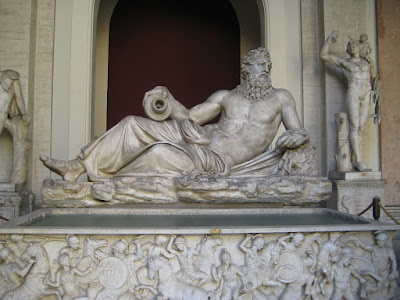
This spiral ramp is one of the first things you see upon entering the Vatican museums. I'm not sure who designed this thing, but it was very awkward walking down it.

I think I took a picture of every ceiling and dome. They are really works of art as well so I've included them throughout this post.

This serene and beautiful courtyard was filled with famous statues.


This is Apollo Belvedere. Discovered in the 15th century, it is thought to be a copy of a lost bronze original made between 350 and 325 BC by Greek sculptor Leochares. It depicts the Greek god Apollo having just shot an arrow. There was also a Roman god Apollo and they were both important deities in mythology as the god of nearly everything like light, the sun, truth, medicine, music, archery and more.


This is Neptune and that's all I know about it.


This is the sculpture of Laocoon and his Sons, unearthed in a vineyard in 1506, but likely carved some time between 42 and 20 BC. It shows Laocoon and his sons being strangled by sea serpents. Laocoon was a Trojan priest of Poseidon who warned his fellow Trojans against the wooden horse presented as a gift from the Greeks.
Interesting factoid . . . when the statue was discovered, Laocoon's right arm was missing, along with part of the hand of one child and the right arm of the other. Artists debated about how the missing arm should be interpreted. Michelangelo suggested that the missing right arms were originally bent back over the shoulder. Others, however believed it was more appropriate to show the right arms extended outwardsin a heroic gesture. The Pope held an informal contest among sculptors to make replacement right arms, which was judged by Raphael. The winner, in the outstretched position, was attached to the statue.
In 1906, an archaeologist discovered a fragment of a marble arm in a builder's yard in Rome. Noting a similarity to the Laocoon group, he presented it to the Vatican Museums where it remained in their storeroom for half a century. In the 1950's the museum decided that this arm - bent, as Michelangelo had suggested - had originally belonged to this Laocoon. The statue was dismantled and the new arm incorporated.
wikipedia
There are many copies of the statue, but this is the original.


Hall after hall like this one. Beautiful floors, columns, ceilings, art, sculptures, guards . . .


This is the Torso of Belvedere, a fragment of a nude malestatue, known to have been carved by Apollonios, son of Nestor (because he signed it) likely in the 2nd century.


These tapestries, called Flemish tapestries, were woven by the workshop of Peter van Aelst in Brussels, Belgium in 1516. They are made in the image of paintings along the walls of the Sistine Chapel done by Italian painter, Raphael (1483-1520).


A Grecian urn. The real thing.

This is the only picture I got of the Sistine Chapel. That "no photos" icon on the sign was not just a suggestion. There were guards, the lights were low, everyone was very quiet and the guards would quickly usher you out if a camera was even spotted. I know because I saw it happen.

I add the Vatican map again to show the size of the chapel compared to the basilica, etc.
Since they were serious about no photos, we didn't risk it. These next pictures I got from the internet.

This one shows the Raphael tapestry paintings mentioned above.
This is the Sistine Chapel. I don't know what I was expecting, but it seemed smaller than I anticipated.

This is the altar wall of the chapel with Michelangelo's The Last Judgment. It depicts the second coming of Christ and God's final judgment of humanity.
Here's a close up of Michelangelo's ceiling, painted between 1508 and 1512. It includes 9 scenes from the Book of Genesis. You can see the famous "hand of God giving life to Adam". It, too, was smaller than I expected. I wouldn't have seen it had it not been pointed out to me. Embarrassing.
More on the mother of all churches . . .



No comments:
Post a Comment